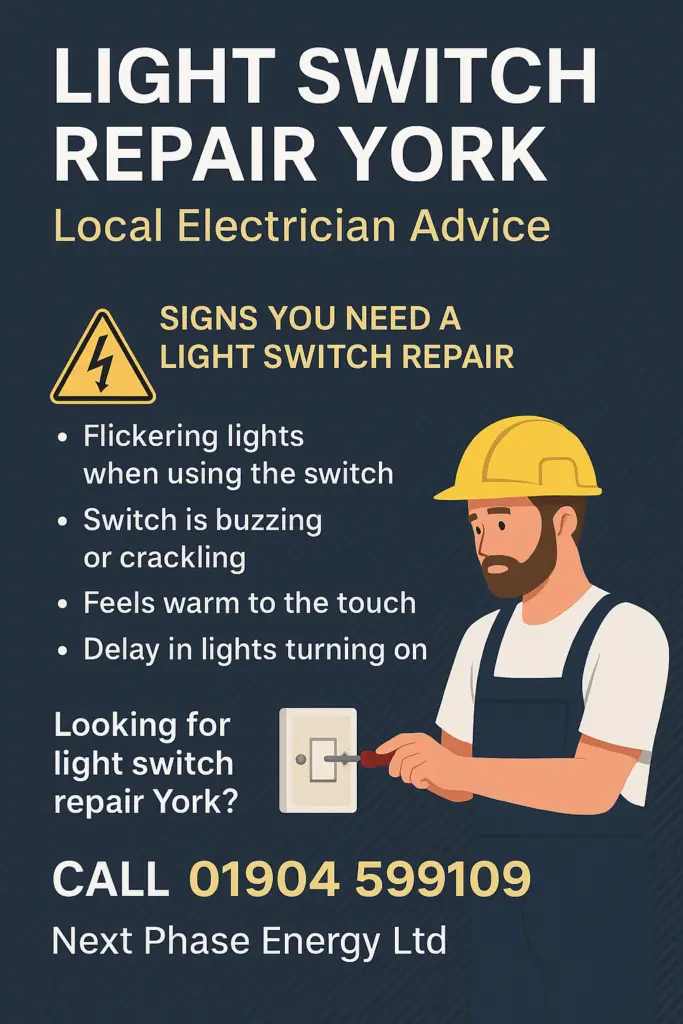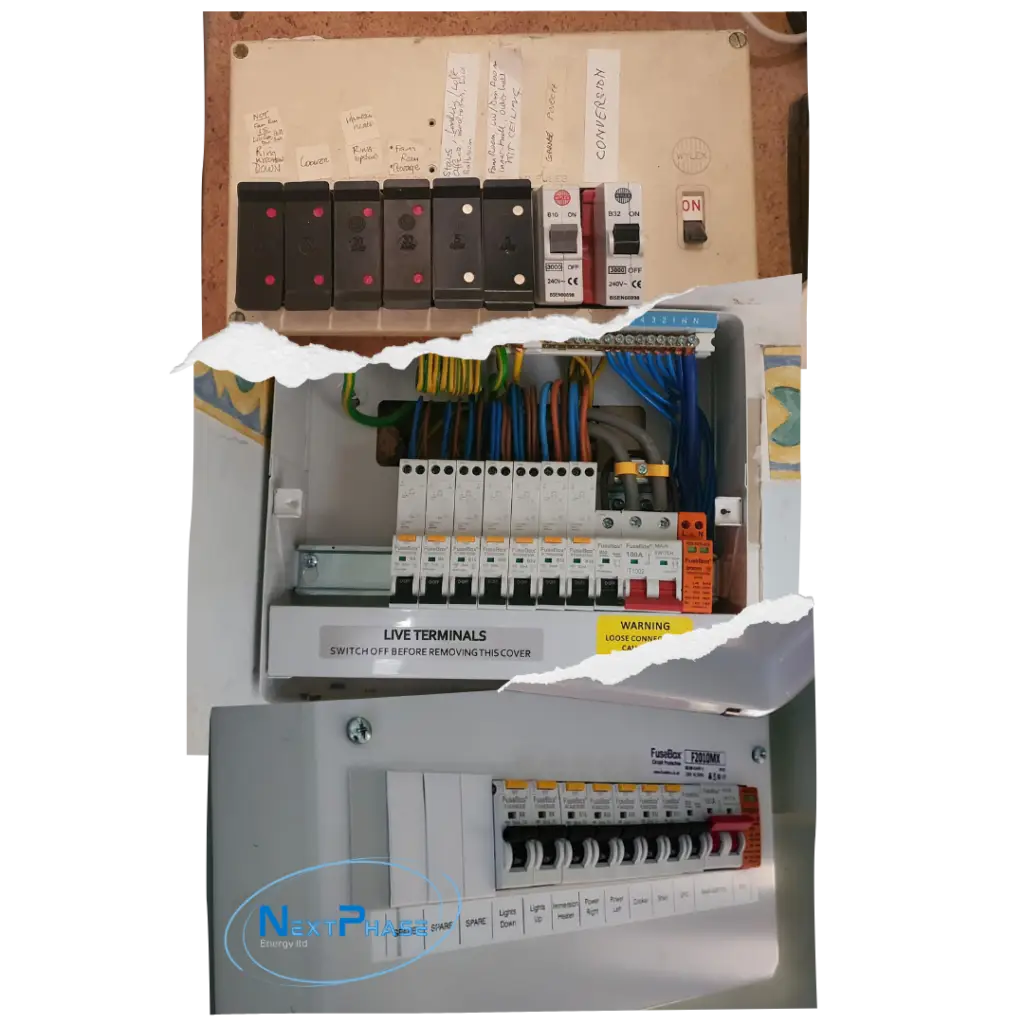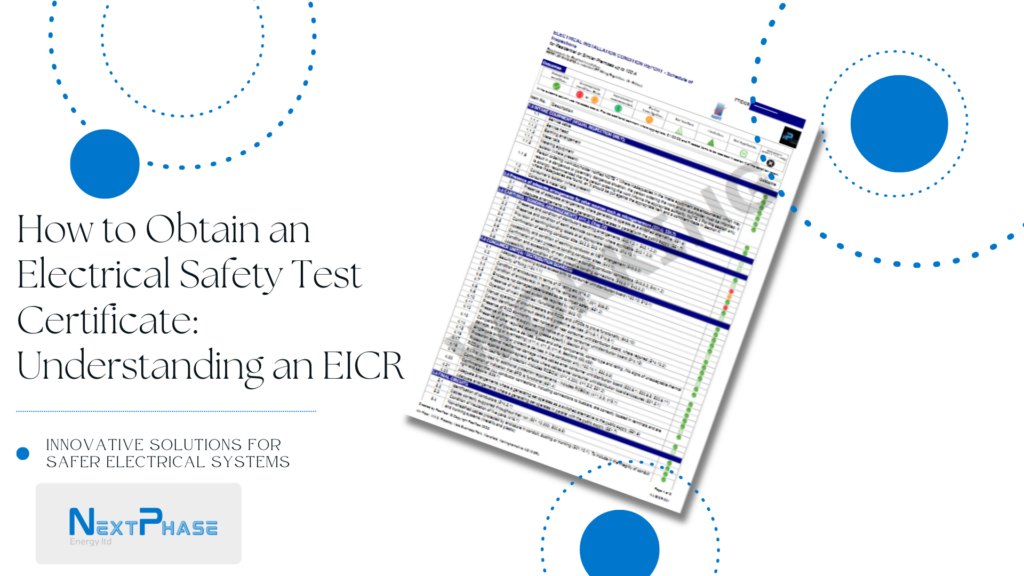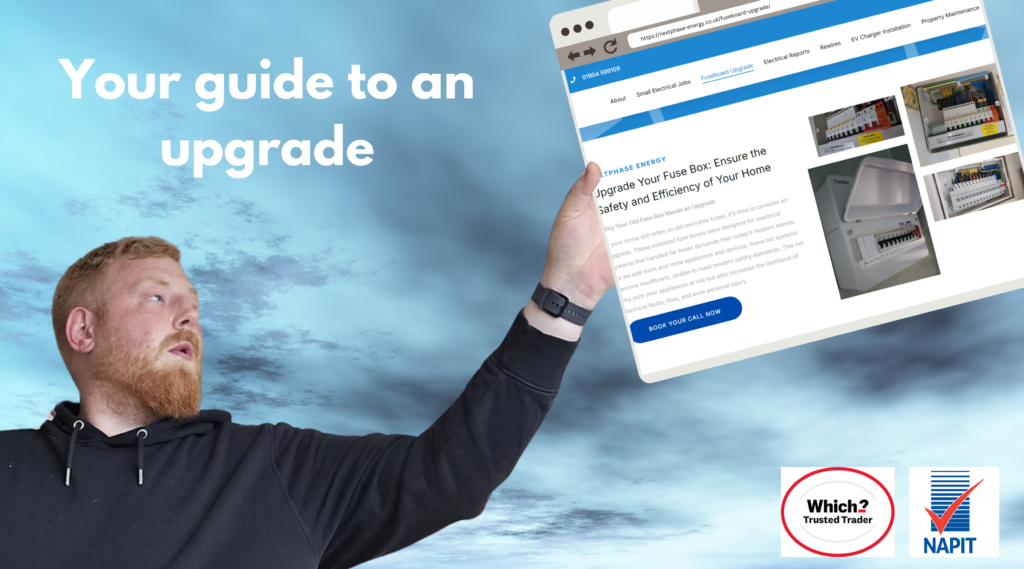Light Switch Repair in York – Local Electrician Advice for Homeowners

If you’re searching for light switch repair in York, you’re not alone. I’m regularly called out to homes across York, Selby, Howden, Goole, Pocklington, and the surrounding villages to deal with flickering, buzzing, or broken switches. It might not seem like a big deal at first, but an ageing or faulty light switch can often be a sign of something more serious within your electrical system, and it’s something I always recommend getting checked sooner rather than later. ⚠️ Common Signs You Might Need a Light Switch Repair These are the most common symptoms I see when I’m called out to inspect faulty switches: If you’ve spotted any of these issues, it’s best not to ignore them. In many cases, what starts as a simple light switch fault can lead to bigger electrical problems if left unresolved. 🔥 Why Ignoring a Faulty Light Switch Can Be Dangerous When I carry out light switch repairs in York, I sometimes find signs of arcing or overheating behind the switch. These can increase the risk of: Even if the switch seems to still “work,” the underlying issue might be worsening in the background. That’s why I always advise customers to get in touch if anything doesn’t seem right. 👷♂️ How I Help Homeowners with Light Switch Repairs in York I’m the sole electrician at Next Phase Energy Ltd, which means when you contact me, you’ll be speaking directly to the person who’s doing the work. My service is straightforward, honest, and personal. If you need light switch repair in York, I’ll come out, take a look, and let you know exactly what’s going on. I’ll only ever recommend repairs or upgrades that are genuinely needed — no pushy sales, just professional advice and high-quality workmanship. 🏡 Specialising in Older Properties Many of the homes I work in around York and nearby towns have been standing for decades. Some still have original wiring, or outdated fittings that don’t meet modern standards. I regularly work with older domestic systems and can advise you if your home could benefit from more than just a switch repair — for example, if the issue suggests a need for a fuse board upgrade or safety inspection. 🧠 What You Shouldn’t Do I often get asked if light switch repairs are something people can do themselves. My answer is always no. Even a simple switch can hide wiring issues that aren’t visible on the surface. It’s always best to call a qualified electrician — especially in older homes. ✅ What My Customers Say “Matt came out the same day to fix a buzzing light switch in our kitchen. He was friendly, quick, and really knowledgeable. Would definitely recommend!”— Sarah T., York 📅 When Should You Get It Checked? If your home is over 20–25 years old, or if you’ve never had an electrical inspection, now is a great time to get your switches and sockets looked at. Small faults are often the easiest and cheapest to fix — if they’re caught early. 📞 Need Light Switch Repair in York? If you’ve noticed any issues with your light switches or just want to make sure everything’s safe, feel free to get in touch with me directly. 📧 Email: Matt@nextphase-energy.co.uk📱 Phone: 01904 599109📝 Or head to my contact page and fill in the quick form.
Why Modern Fuseboards Matter: Surge Protection, RCBOs & Electrical Safety Explained

Modern Fuseboards & Surge Protection Still running on a fuseboard from 1985? You’re not alone. Many homes across Selby and Goole are still relying on outdated consumer units that lack the protections modern systems offer. What Are RCBOs? RCBOs (Residual Current Breakers with Overcurrent protection) combine the functions of both an RCD and an MCB into a single device. Why it matters: This means more safety, less disruption, and better protection for you and your property. Why Add Surge Protection? Modern homes are full of sensitive devices — smart TVs, routers, laptops, EV chargers, and more. A Surge Protection Device (SPD) shields your entire home from spikes caused by things like lightning or grid switching. Benefits: Why Fuseboard Upgrades Are Worth It Upgrading isn’t just about passing inspection — it’s about: We don’t push people into work they don’t need — but if your system’s outdated, we’ll give you clear advice and let you decide. Need Advice or a Quote? We carry out fuseboard upgrades across Selby, Goole, Howden, and surrounding areas. Whether you’re renovating, renting, or just want your electrics up to scratch, we’ll make it simple and safe. 👉 [ Request a Quote ]
The Hidden Dangers of Old Fuseboards — Why Modern Protection Matters

Most homeowners rarely think about their fuseboard—until something goes wrong. But the truth is, that small grey box could be one of the most important safety systems in your home. If your electrical system still relies on outdated protection (no RCDs, no surge protection, fuse wire instead of circuit breakers), you could be exposing your family and property to avoidable risks. In this post, we’ll break down what modern protection looks like, and why it matters more than ever. 🔌 What Are RCBOs and SPDs — And Why Should You Care? RCBOs: Residual Current Devices with Overcurrent Protection RCBOs are the modern standard in fuseboard safety. Unlike old breakers that only shut off power during an overload, RCBOs can also detect life-threatening faults, like current leaking to earth — a common cause of electric shocks. In short:Old breakers protect wires. RCBOs protect people. SPDs: Surge Protection Devices Power surges happen more than you think — lightning strikes, energy supplier faults, and even faulty appliances can send damaging voltage through your system. SPDs absorb that spike before it fries your electronics or starts a fire. Without them, you could lose thousands in damaged appliances. ✅ Why an RCBO Fuseboard with SPD Makes Sense Upgrading to an RCBO board with surge protection doesn’t just bring your home up to modern standards — it gives you: 🧾 The EICR — Your Electrical Safety MOT Before upgrading your fuseboard, it’s smart to get an Electrical Installation Condition Report (EICR). It’s like an MOT for your electrics. We often find homes in the Selby area still using circuit breakers without any RCD protection—which means the system might be shielding your cables, but not you or your family. That’s a serious safety gap. If your EICR flags issues, we’ll walk you through your options clearly — no jargon, no pressure. ⚠️ The Risks of Sticking with an Old Fuseboard Think your old system is “fine”? Here’s what we see every week: 🔥 Increased Fire Risk Old fuseboards are more likely to overheat and spark electrical fires — especially in homes with high appliance use. ⚡ Frequent Faults & Power Cuts Outdated gear doesn’t handle modern electrical loads well. Tripping circuits and faulty breakers become a common annoyance. 😬 Risk of Electric Shock Without RCD protection, your system may not shut down fast enough in a fault — and that can be fatal. 💸 Financial Loss A small fault can ruin appliances, lead to wiring damage, or cause insurance issues after a fire. 🛠️ It’s Not Just a Fuseboard — It’s Your Home’s Safety Net Upgrading your consumer unit is one of the most impactful improvements you can make to a home — both for safety and for future-proofing. Whether you’re renovating, adding new circuits, or just want peace of mind, this is one of those upgrades that pays for itself in protection and peace of mind. 📍 Areas We Cover We proudly serve homeowners across: ✅ Thinking About an Upgrade? We make it easy. From a free quote to a safe, clean install — no hard sell, just honest advice from a qualified local electrician. [ Book Your Fuseboard Quote ]Or give us a call on 01904 599109 and we’ll walk you through your options.
Shocking Bills Ahead? April’s Energy Price Rise Explained – And 5 Electrical Fixes to Cut Your Costs

Rising energy prices aren’t just numbers – they hit home. But you’re not powerless. With some smart electrical improvements, you can take control of your energy usage and your bills.
How to Obtain an Electrical Safety Test Certificate: Understanding an EICR

By Matt Crabb Electrical safety is something no property owner should ignore. Whether you’re a landlord, homeowner, or business owner, ensuring your electrics are safe is a legal requirement in many cases—and a smart decision for everyone else. One of the best ways to guarantee electrical safety is by obtaining an Electrical Installation Condition Report (EICR). But what exactly is an EICR, and how do you get an electrical safety test certificate? Let’s break it down in simple, easy-to-understand terms. What is an EICR? An Electrical Installation Condition Report (EICR) is an inspection that checks the fixed wiring installation in a property. Unlike Portable Appliance Testing (PAT), which focuses on plug-in electrical items, an EICR examines things like: The goal? To identify defects, wear and tear, or potential safety risks before they become a real hazard. Why Do You Need an EICR? An EICR isn’t just a box-ticking exercise—it’s crucial for safety and compliance. Here’s why: How to Get an Electrical Safety Test Certificate (EICR) 1. Find a Qualified Electrician Only a certified electrician can perform an EICR. Look for one registered with recognised bodies like NAPIT and other accreditation like Which? Trusted traders. Hiring a trusted professional ensures the job is done correctly. 2. Schedule an EICR Inspection The electrician will visit your property and perform: 3. Receive the EICR Report Once testing is complete, the electrician will issue an EICR certificate with one of the following classifications: 4. Complete Any Necessary Repairs If the EICR report highlights faults (C1 or C2 issues), they must be rectified before the certificate can be issued. Your electrician may be able to fix them immediately or schedule remedial work. 5. Store Your Certificate Safely Once you receive your EICR certificate, keep it in a safe place. Landlords must provide a copy to new tenants and local authorities upon request. How Often Should You Get an EICR? However, if you’ve recently had major renovations, water damage, rodent issues, or frequent electrical faults, you should schedule an EICR sooner. FAQs About an EICR How long does an EICR take? It depends on the property size and number of circuits, but typically: What happens if I get an unsatisfactory an EICR? If your EICR flags C1 or C2 issues, you must fix them ASAP to receive a satisfactory certificate. Your electrician can often handle minor fixes on the spot. How much does an EICR cost? Costs vary depending on: Expect to pay between £250 – £500 for a residential EICR, while commercial properties may cost more. Do I need an EICR for a new build? New properties typically receive an Electrical Installation Certificate (EIC) instead. However, after five years, an EICR is required. FAQs About NextPhase Energy Ltd Who is NextPhase Energy Ltd? NextPhase Energy Ltd is a leading electrical services provider, offering EICRs, electrical installations, and safety inspections across the UK. Are NextPhase Energy Ltd electricians certified? Yes! All electricians at NextPhase Energy Ltd are fully qualified and accredited by NAPIT and Which?. Does NextPhase Energy Ltd provide remedial work? Absolutely. If your EICR identifies faults, our team can carry out repairs quickly and affordably. How can I book an EICR with NextPhase Energy Ltd? Simply call us or book online! Our team is ready to help with all your electrical safety needs. Final Thoughts: Don’t Risk Electrical Safety! An EICR is a simple but essential step to ensure your property’s electrics are safe, legal, and compliant. Whether you’re a landlord, homeowner, or business owner, booking an inspection with a qualified electrician is the best way to protect your property and its occupants. Need an EICR? Get in touch with NextPhase Energy Ltd today!
Why RCBOs Are Essential for Modern Electrical Safety

Are you a property owner in York, Goole, or nearby? Protect your home or business with RCBOs—modern devices that prevent electric shocks, overcurrent, and short circuits while isolating faults to a single circuit.
Unlike outdated systems, RCBOs combine safety and convenience, ensuring minimal disruption and enhanced protection for high-risk areas like kitchens and bathrooms. They’re an investment in peace of mind for your family or business. Upgrade to RCBOs today and enjoy safer, smarter electrical systems!
Why Upgrading Your Fuse Board is Essential: A Guide for Property Owners in York and Surrounding Areas

Your fuse board, also called a consumer unit, is the heart of your electrical system.
